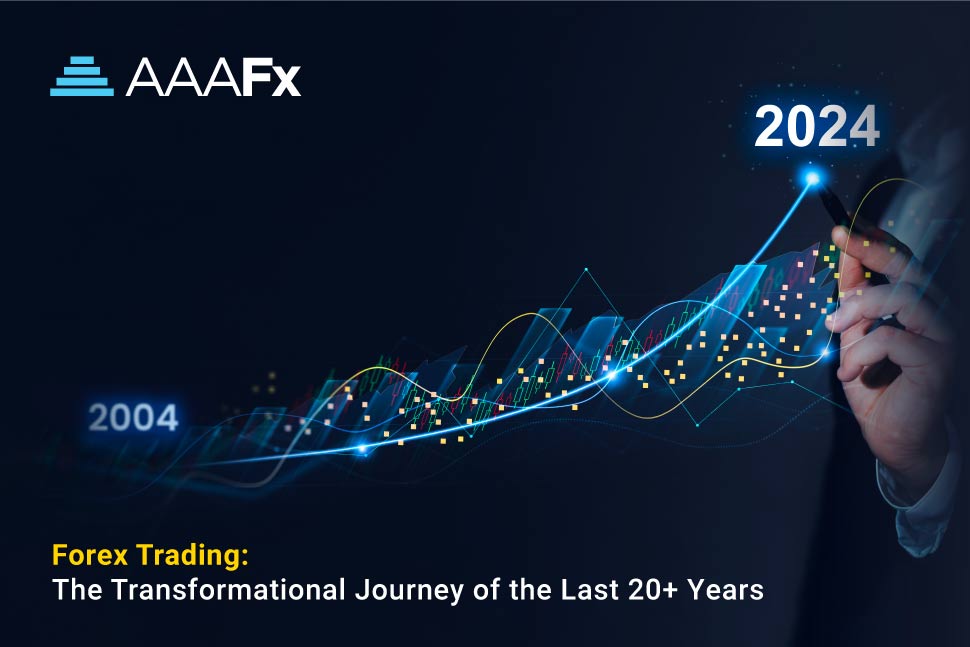
- All Instrument Types
- Indices
- Equities
- ETFs
- Funds
- Commodities
- Currencies
- Crypto
- Bonds
- Certificates
Please try another search

Forex Trading: The Transformational Journey of the Last 20+ Years
Dive into the recent history of currency trading from the Gold Standard to digital assets with AAAFx.

 for AAAFx
for AAAFx

Forex trading or foreign exchange is the most dynamic and liquid market where currencies are bought and sold globally. Over the past two decades, Forex trading has undergone a spectacular transformation, shifting from a traditional and centralized system to a digital and decentralized one. This article looks closely at the evolution of Forex trading over the past 20+ years, charting its path to the digital era.
Humble beginnings
Forex trading as we know it started in 1971, with the rise of the NASDAQ as the world’s first electronic stock market. However, in terms of practice, trading was far from advanced. Then, traders received manually filled-out buy and sell order forms in pigeonholes housed in the trading pit. Extensive telephone communication between traders, buyers and sellers followed. It took hours to place an order. The industry was craving transformation.
The great transformation
Fast-forward nine years, in the 1980s, the trading world witnessed the rise of electronic trading systems. Thomas Peterffy, a renowned stock broker, contributed to the creation of the first electronic trading platform for securities. It was a pivotal moment for forex trading, which abandoned traditional practices and transitioned to more modern, electronic trading practices.
Later, in the 1990s, the .com boom brought about even more unprecedented technological advancements, empowering retail traders to enter the once-exclusive Forex market. But what was the catalyst of this transformation?
The emergence of Electronic Communication Networks (ECNs) changed the face of foreign exchange trading. Thanks to these developments, retail traders were able to seamlessly access interbank markets over the counter and benefit from tighter spreads, better pricing, quicker execution and greater transparency for the first time. A new era was dawning.
The new era
From ECNs, leaping through the years to the 3rd millennium, further innovations and greater participation in the currency trading market were the hallmarks of the early 2000s. All this thanks to the Internet, the big global network keeping everything and everyone connected!
The arrival of the Internet made instant trading possible. Traders, no matter where they were around the world simply needed to switch on their PC and log in to the platform to get started. It was now that innovative trading technologies such as the MetaTrader platforms entered the market.
The arrival of MetaTrader 4 in 2005 was eagerly awaited by the industry and a groundbreaking event. For the first time, retail traders could trade around the clock, across multiple timeframes and markets. Forex trading was becoming global.
Between 2005 and 2010, automated trading systems and mobile platforms shook up the industry. If the Internet connected traders with the financial markets in milliseconds, mobile technology put the financial markets in traders’ hands.
By simply downloading an app, one could access thousands of asset classes and loads of opportunities in the same way they would on their desktop PC. Now considered the norm, the advent of mobile technology created a seismic shift in the Forex space. It was a wake-up call for brokers who had to embrace change and become mobile-first.
2009 and 2010 witnessed the expansion of social trading platforms, which enabled traders to follow and copy the strategies or trades of more experienced traders while fostering knowledge sharing in a community-driven environment.
2010 also saw the development of MetaTrader 5. Building on MetaTrader 4’s legacy, this new kid on the block facilitated access to both OTC products such as Forex and CFDs and equities at a low cost.
In parallel, cryptocurrencies were also gaining significant traction, with Bitcoin and Ethereum jumping from record highs to record lows in a matter of days. Enjoying the attention of millions of traders globally, cryptos soon became the next must-have asset class in the pipeline of brokers seeking to reach crypto enthusiasts globally.
The brave new world
All these tidal shifts gave rise to opportunities and challenges for online brokers. To attract and retain traders, brokerage firms have had to find ways to diversify their offerings and fast. One such broker is AAAFx.
In the online trading space for 14 years, AAAFx is one of the industry veterans. Focused on innovation, it places traders at the heart of its offering. The broker comes with a tailored offering for every need.
AAAFx provides access to over 70 major, minor and exotic currency pairs on its MetaTrader 4 and MetaTrader 5 platforms, on any device. Alongside these, traders can also access a number of crypto-based pairs, enjoying exposure to these much-coveted assets, as well as CFDs on stocks, commodities and indices.
Welcoming traders of all levels, AAAFx takes pride in its commission-free trading on Forex. The broker provides access to three account types built around its ECN offering. Tailored to meet every budget, this offering is centered on razor-thin spreads, and other perks such as micro-lot trading, zero fees on deposits and withdrawals, and much more.
Trading tools such as trading calculators and automated access to social trading via ZuluTrade, one of the oldest social trading platforms, allow traders to explore Forex trading in multiple ways, according to their goals.
In the context of a rapidly evolving financial landscape, as new technologies and trends arise, AAAFx stands out as one of the veteran brokers able to pass the test of time. With an extensive offering that allows traders the freedom of choice across diverse asset classes, it is one of the brokers worth exploring.
Trading Contracts for Difference (CFDs) on margin carries a high level of risk and may not be suitable for all investors. Before deciding to trade CFDs, you should carefully consider your trading objectives, level of experience and risk appetite. It is possible for you to sustain losses that exceed your invested capital, and therefore you should not deposit money that you cannot afford to lose. Please ensure you fully understand the risks and take appropriate care to manage them.




